Related Research Articles
In Welsh mythology, Gwythyr ap Greidawl was a rival of Gwyn ap Nudd, a deity connected with the otherworld. In the Middle Welsh prose tale Culhwch ac Olwen, he is named as a member of Arthur's retinue and takes part in the quest to win the hand of Olwen for Arthur's cousin, Culhwch. Gwthyr would join Arthur on a journey to Pennant Gofid in Hell to retrieve the blood of the witch Orddu. His father is Greidawl Galldonyd, a fellow knight in Arthur's court. In Bonedd yr Arwyr, his genealogy is given as Gwythyr son of Greidawl the son of Enfael the son of Deigyr the son of Dyfnwal the son of Ednyfed the son of Maxen the son of Llywelyn. The Welsh Triads name him as the father of Arthur's second wife, also named Gwenhwyfar.

Modron ("mother") is a figure in Welsh tradition, known as the mother of the hero Mabon ap Modron. Both characters may have derived from earlier divine figures, in her case the Gaulish goddess Matrona. She may have been a prototype for Morgan le Fay from the Arthurian legend.

The Mabinogion is a collection of the earliest Welsh prose stories, compiled in Middle Welsh in the 12th–13th centuries from earlier oral traditions. There are two main source manuscripts, created c. 1350–1410, as well as a few earlier fragments. Often included in the broader mythologies described as the Matter of Britain, the Mabinogion consists of eleven stories of widely different types, offering drama, philosophy, romance, tragedy, fantasy and humour. Strictly speaking, the Four Branches of the Mabinogi are the main sequence of related tales, but seven others include a classic hero quest, "Culhwch and Olwen"; a historic legend, complete with glimpses of a far off age, in "Lludd and Llefelys"; and other tales portraying a very different King Arthur from the later popular versions.
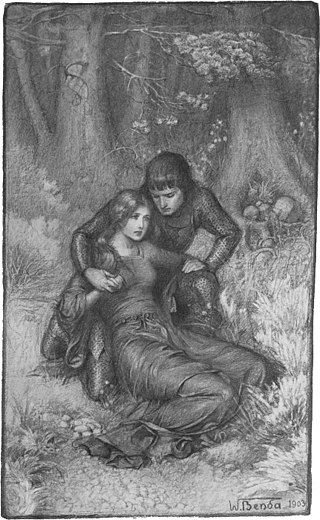
In the Matter of Britain, Igraine is the mother of King Arthur. Igraine is also known in Latin as Igerna, in Welsh as Eigr, in French as Ygraine, in Le Morte d'Arthur as Ygrayne—often modernised as Igraine or Igreine—and in Parzival as Arnive. She becomes the wife of Uther Pendragon, after the death of her first husband, Gorlois.

Culhwch and Olwen is a Welsh tale that survives in only two manuscripts about a hero connected with Arthur and his warriors: a complete version in the Red Book of Hergest, c. 1400, and a fragmented version in the White Book of Rhydderch, c. 1325. It is the longest of the surviving Welsh prose tales. Lady Charlotte Guest included this tale among those she collected under the title The Mabinogion.
Morgause is a popular variant of the figure of the Queen of Orkney, an Arthurian legend character also known by various other names and appearing in different forms of her archetype. She is notably the mother of Gawain and often also of Mordred, both key players in the story of her brother King Arthur and his downfall.
Eudaf Hen is a figure of Welsh tradition. He is remembered as a King of the Britons and the father of Elen Luyddog and Conan Meriadoc in sources such as the Welsh prose tale The Dream of Macsen Wledig and Geoffrey of Monmouth's Latin chronicle Historia Regum Britanniae. He also figures into Welsh genealogies. Geoffrey of Monmouth calls him Octavius, a corruption and faux-Latinization of Old Welsh/Breton Outham. According to the medieval Welsh genealogy from Mostyn MS. 117, Eudaf was a direct ancestor of King Arthur.
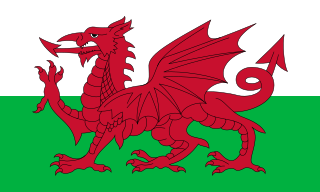
Welsh mythology consists of both folk traditions developed in Wales, and traditions developed by the Celtic Britons elsewhere before the end of the first millennium. As in most of the predominantly oral societies Celtic mythology and history were recorded orally by specialists such as druids. This oral record has been lost or altered as a result of outside contact and invasion over the years. Much of this altered mythology and history is preserved in medieval Welsh manuscripts, which include the Red Book of Hergest, the White Book of Rhydderch, the Book of Aneirin and the Book of Taliesin. Other works connected to Welsh mythology include the ninth-century Latin historical compilation Historia Brittonum and Geoffrey of Monmouth's twelfth-century Latin chronicle Historia Regum Britanniae, as well as later folklore, such as the materials collected in The Welsh Fairy Book by William Jenkyn Thomas (1908).
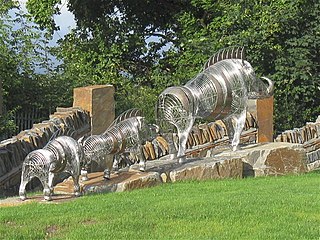
Twrch Trwyth, is a fabulous wild boar from the Legend of King Arthur, of which a richly elaborate account of its hunt described in the Welsh prose romance Culhwch and Olwen, probably written around 1100.
Cuneglasus was a prince of Rhos in Gwynedd, Wales, in the late 5th or early 6th century. He was castigated for various sins by Gildas in De Excidio Britanniae. The Welsh form Cynlas Goch is attested in several genealogies of the Rhos royal line. The two names are assumed to refer to the same ruler.
Sanddef Pryd Angel is a figure of Welsh tradition. He usually figures as a warrior of King Arthur's court, and is distinguished by his great beauty, which gives him his epithet Pryd or Bryd Angel.
Peibo Clafrog, was King of Ergyng in south-east Wales in the 5th or 6th century. He is chiefly known from the legends of Saint Dubricius, who was supposedly his grandson. The contemporary rendering of this name would seem to be Peibio, as in Garthbeibio, a parish in Montgomeryshire, or Ynys Beibio, near Holyhead.
King Gwrfoddw was the King of Ergyng, a south-east Welsh kingdom of the early medieval period. He usurped the throne from Gwrgan ap Cynfyn.
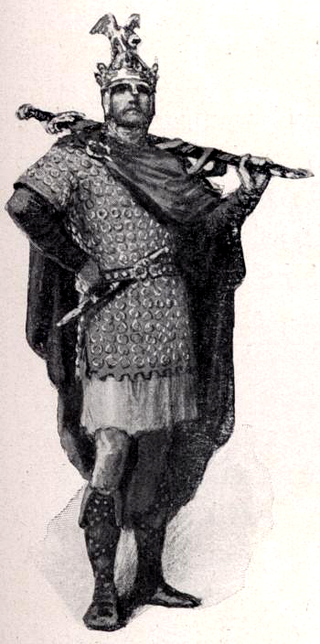
King Arthur's family grew throughout the centuries with King Arthur's legend. The earliest Welsh Arthurian tradition portrays Arthur as having an extensive family network, including his parents Uther Pendragon and Eigyr (Igraine), wife Gwenhwyfar (Guinevere), nephew Gwalchmei (Gawain), brother, and several sons; his maternal lineage is also detailed, linking him to relatives such as his grandfather. This complex familial structure has been both simplified and expanded in the common tradition of shared British, French, and other medieval European chronicles and romances, which instead introduced new characters, such as Arthur's half-sisters including Morgan, their children including Mordred, and others. Arthur's lineage was later claimed by various rulers, in particular the House of Tudor and Scottish clans, reflecting the enduring legacy of his familial ties in medieval and early modern genealogies.
Goreu fab Custennin is a hero of Welsh and early Arthurian mythology, the son of Custennin, and cousin to Arthur, Culhwch and Saint Illtud through their grandfather Amlawdd Wledig. He is a significant character in the Middle Welsh Arthurian tale Culhwch and Olwen, and also appears in a number of other medieval texts. His name may be derived from Gorneu; "of Cornwall."
Drudwas ap Tryffin is a knight of King Arthur's court in early Arthurian mythology and the owner of the magical Adar Llwch Gwin. His father, Tryffin, is described as the king of Denmark, while his sister, Erdudwyl, was, according to The Death of Drudwas, supposedly a “mistress” of Arthur.

Mên Scryfa is an inscribed standing stone in Cornwall, England, United Kingdom. The inscription, dating to the early medieval period, commemorates "Rialobranus son of Cunovalus."
Saint Gwrddlew or Gwrtheli, Gartheli, was a pre-congregational saint of 5th century medieval Wales.
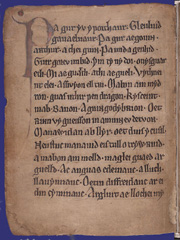
Poem 31 of the Black Book of Carmarthen, a mid-13th century manuscript, is known from its first line as Pa gur yv y porthaur? or Pa gur, or alternatively as Ymddiddan Arthur a Glewlwyd Gafaelfawr. It is a fragmentary, anonymous poem in Old Welsh, taking the form of a dialogue between King Arthur and the gatekeeper Glewlwyd Gafaelfawr, in which Arthur boasts of his own exploits and those of his companions, especially Cai the Fair. Pa gur is notable for being one of the earliest vernacular Arthurian works, and for alluding to several early adventures of Arthur which are now lost. Its precise age is not known and has been the subject of wide-ranging disagreement, but scholarly opinion now tends to favour a date of c. 1100.
Indeg, daughter of Garwy Hir, was known in early Welsh legend as one of the three mistresses of King Arthur. Though her story seems to have survived down to the later Middle Ages, when she was frequently cited by Welsh poets as a standard for beauty, it has since been lost.
References
- ↑ Geiriadur Prifysgol Cymru, Part 26, Gwasg Prifysgol Cymru, 1974, p. 1682.
- ↑ Wade-Evans, A.W. Welsh Christian Origins (Oxford, 1934) pp.102 quoted in Bartrum, Peter C. ed. Welsh Classical Dictionary: People in History and Legend Up to About A.D. 1000 (National Library of Wales, February 1994) pp.14-15 ISBN 978-0907158738
- ↑ Bartrum, Peter C. ed. Bonedd yr Arwyr (Unpublished genealogical material concerning the heroes of early Welsh history and legend, 1959).
- 1 2 3 Bartrum, Peter C. ed. Welsh Classical Dictionary: People in History and Legend Up to About A.D. 1000 (National Library of Wales, February 1994) ISBN 978-0907158738
- ↑ Bartrum, Peter C. ed. Early Welsh Genealogical Tracts (University of Wales, 1966)
- ↑ Davies, John. A History of Wales. Penguin (New York), 1994. ISBN 0-14-014581-8.
- 1 2 3 Bruce, Christopher W. The Arthurian Name Dictionary (Routledge, 2013) ISBN 9781136755385
- ↑ Rees, Rice. The Welsh Saints (1839) - see External References, below)
- ↑ R. Bromwich, Trioedd Ynys Prydein: the Welsh Triads (Cardiff: University of Wales, 1978), pp.372–3.
- ↑ David Nash Ford. "WEST COUNTRY ROYAL PEDIGREE" . Retrieved 28 November 2020.
- ↑ Parker, Will (2016). "Culhwch and Olwen Translation". Culhwch ac Olwen. Footnotes 157–159. Retrieved 4 May 2022.
- ↑ Parker, Will (2016). "Culhwch and Olwen Translation". Culhwch ac Olwen. Footnotes 195–197. Retrieved 4 May 2022.
- ↑ Norma Lorre Goodrich, King Arthur (HarperPerennial; New edition, 1989) ISBN 978-0060971823
- ↑ Bromwich, R. and Evans, D. Simon. Culhwch and Olwen. An Edition and Study of the Oldest Arthurian Tale (Cardiff: University of Wales Press, 1992), pp.44-5 ISBN 978-0708326190